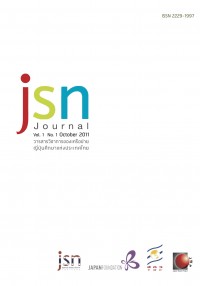การใช้ความเปรียบในวรรณกรรม โทะซะนิกกิ
Main Article Content
บทคัดย่อ
วรรณกรรมเรื่อง โทะซะนิกกิ (土佐日記)เป็นวรรณกรรม ในรูปแบบบันทึกเล่มแรกของญี่ปุ่น เขียนขึ้นในสมัยเฮอันราว ปี ค.ศ. 936 โดยคิโนะท์ซุระยุกิ (紀貫之) ผู้เขียนได้บรรยาย ทิวทัศน์ และเหตุการณ์ในระหว่างการเดินทางโดยเรือจากเมืองโทะซะกลับมายังบ้านที่เกียวโตเมืองหลวง คิโนะท์ซุระยุกิเป็นกวีที่มีชื่อ ด้านการแต่งกลอนญี่ปุ่นในสมัยเฮอัน ในโทะซะนิกกิ ก็มีกลอนญี่ปุ่นอยู่ถึง 57 บท และมีการใช้กลวิธีการประพันธ์แบบต่างๆ ในบันทึกการเดินทางนี้โดยเฉพาะอย่างยิ่งกลวิธีการใช้ความเปรียบซึ่งบางกลวิธีเพิ่งเริ่มปรากฏใช้ในกลอนญี่ปุ่นในยุคของคิโนะท์ซุระยุกิ บทความวิจัย นี้มีวัตถุประสงค์เพื่อศึกษากลวิธีการใช้ความเปรียบในวรรณกรรม โทะซะนิกกิ โดยแบ่งความเปรียบออกเป็น 3 ประเภทคือ อุปมา (比喩) การมองเหมือน (見立て) และบุคลาธิษฐาน (擬人法) จากการศึกษาพบว่า กลวิธีการใช้ความเปรียบดังกล่าวปรากฏบ่อยในทั้งในส่วนที่เป็นกลอนและร้อยแก้วในโทะซะนิกกิ โดยมักเป็นความเปรียบ ที่มีเนื้อหาเกี่ยวโยงกับทะเลหรือแม่น้ำ อันเป็นการช่วยขับเน้นบรรยากาศการเดินทางทางน้ำอันเป็นเนื้อหาหลักของบันทึกนี้ และยังเป็นการช่วยเสริมสร้างจินตภาพให้แก่ผู้อ่าน อีกทั้งยังช่วยสื่ออารมณ์และความรู้สึกนึกคิดของผู้เขียนอีกด้วย
The Usage of Figurative Expression in Tosanikki
Attaya Suwanrasa
Faculty of Arts, Chulalongkorn University
Tosanikki is the first Japanese diary literary works written in 936 A.D. during Heian period by Ki no Tsurayuki. The author describes scenery and events occurred during the sea trip from Tosa to his hometown, the capital Kyoto. Ki no Tsurayuki was a famous Japanese poet in Heian Period. There are 57 Japanese poems in Tosanikki. Many rhetorical techniques are used in this travel diary especially usage of figurative expression in which some started being used in Ki no Tsurayuki’s period. This article aims to study about the techniques of using figurative expression in Tosanikki by classifying them into 3 types : simile, mitate and personification. From this study, it is found that these techniques often appear both in prose and verse in Tosanikki and most of them comprise contents relating to sea or river that help accentuate the ambiance of the sea trip which is the theme of this travel diary. In addition, they help create image in reader’s mind and also help express the author’s thought and emotion.
Article Details
ข้อความและข้อคิดเห็นต่างๆ ในบทความเป็นของผู้เขียนบทความนั้นๆ ไม่ใช่ความเห็นของกองบรรณาธิการหรือของวารสาร jsn Journal


